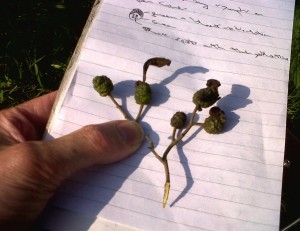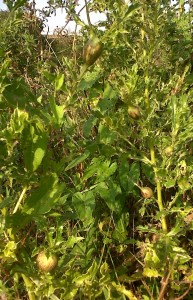The Alder Tongue Gall, which I found on the cones of an Alder along By-way 105 on the lower Cray yesterday (September 9th) may be a new Bexley record. The fact that ‘Britain’s Plant Galls, a photographic guide’ by Michael Chinery (WildGuides, 2011) says it is spreading, but still appears to be absent from the south east, and that the NBN gateway map (albeit undated) has only 2 records for Kent and none for London, suggests it could even be a new record for the capital, but I will have to make inquiries about that.
The gall looks like it says on the tin, a tongue-shaped outgrowth from the cones, caused by the fungus Taphrina alni. Fungal spores being readily shifted around the country on the wind it could, of course, have gained a foothold in our part of the world in the few years since the book was published and been noted elsewhere, but it doesn’t appear in GiGL’s 2013 biodiversity data for Bexley. I will certainly be looking closely at Alders in other locations such as the Shuttle and Danson Park from now on.

These Alder Tongue Galls from the Cray, show that the fungus Taphrina alni has spread into south-east England from the west. (Photo: Chris Rose)
Armed with all this newly discovered information about galls, I set out to look for them at the Thames Road Wetland site I manage as well, confident that I could thereby increase the known species count. Indeed five different galls, caused by five different species were found:
- Rust on Common Mallow, caused by the fungus Puccinia malvacearum (the same species that attacks Hollyhocks)
- The leaf rib gall of Ash caused by the gall midge Dasineura fraxini
- The shoot tip gall of Hawthorn caused by the gall midge Dasineura crataegi
- The Sycamore leaf gall caused by the gall mite Aceria cephaloneus
- The Germander Speedwell shoot tip/leaf gall caused by the gall midge Jaapiella veronicae
Despite the large amount of Ground Ivy at the east end of the site, none of the galls found on this species could be found, nor those that infect Bird’s-foot Trefoil or Yarrow, though a thorough search was not made of these latter species.
More stem galls of Creeping Thistle, previously recorded from the site, were found. These shelter the larvae of the picture-winged fly Urophora cardui.

Five stem galls of Creeping Thistle, produced by a fly, are seen by the River Wansunt at Thames Road Wetland. (Photo: Chris Rose)
Because galls are quite distinctive and largely host-species specific, getting into galls looks a good and relatively easy way to increase the species count at your local wildlife site, as well as giving an insight into yet another facet of inter-species interactions.
[Chris Rose]
